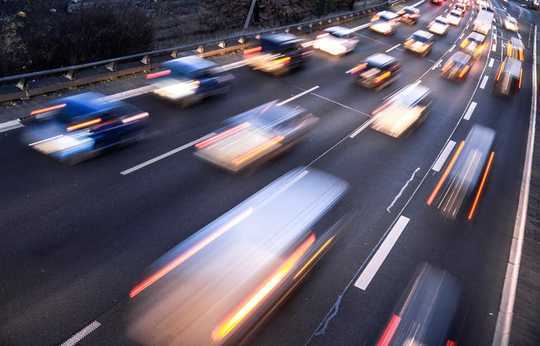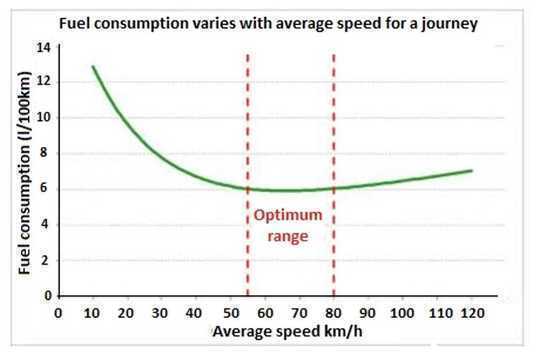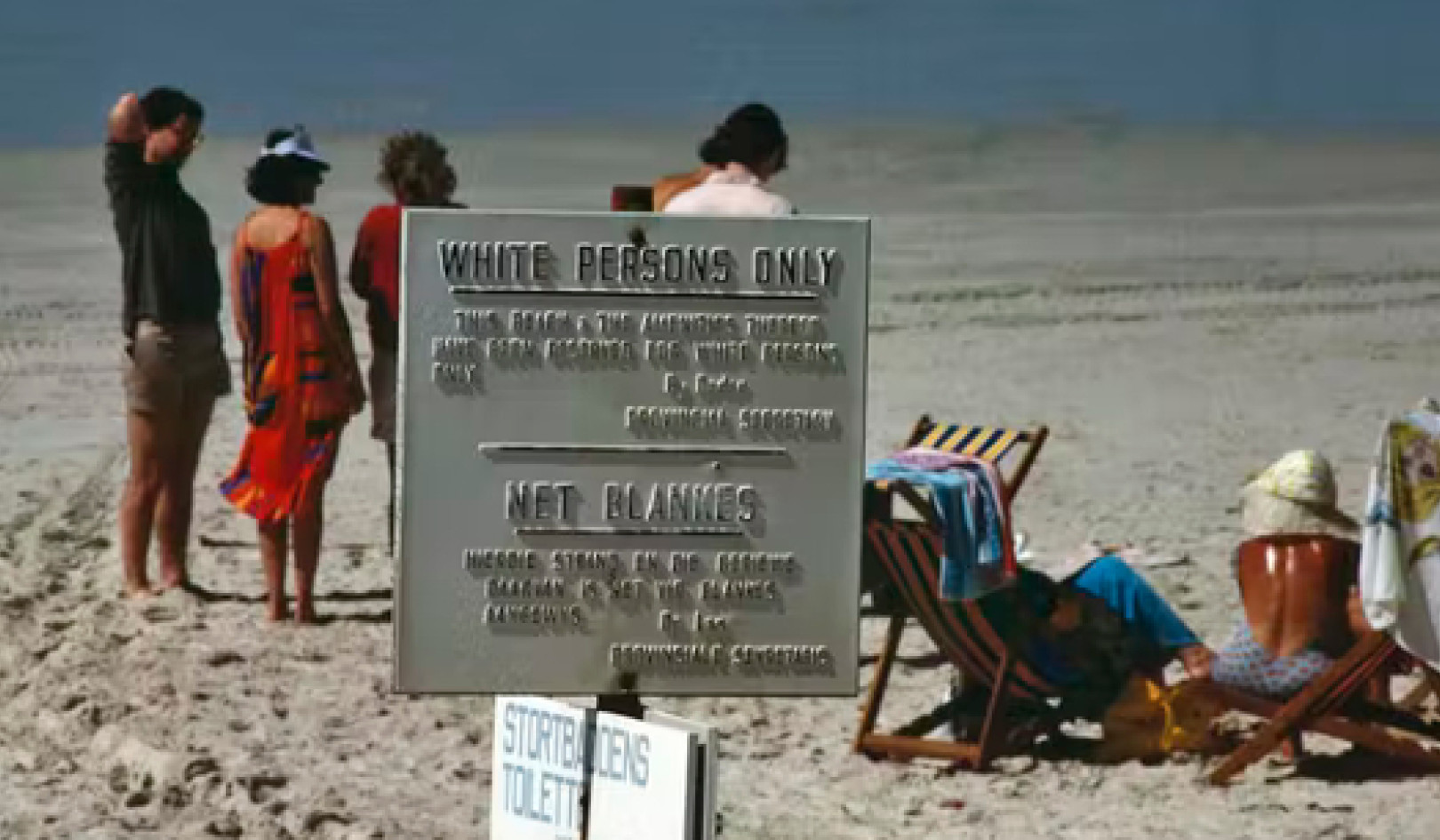 SP Photo/Shutterstock CC BY-ND
SP Photo/Shutterstock CC BY-ND
Every car has an optimal speed range that results in minimum fuel consumption, but this range differs between vehicle types, design and age.
Typically it looks like this graph below: fuel consumption rises from about 80km/h, partly because air resistance increases.
 Author provided
Author provided
But speed is only one factor. No matter what car you are driving, you can reduce fuel consumption (and therefore emissions) by driving more smoothly.
This includes anticipating corners and avoiding sudden braking, taking the foot off the accelerator just before reaching the peak of a hill and cruising over it, and removing roof racks or bull bars and heavier items from inside when they are not needed to make the car lighter and more streamlined.
Driving wisely
In New Zealand, EnergyWise rallies used to be run over a 1200km course around the North Island. They were designed to demonstrate how much fuel could be saved through good driving habits.
The competing drivers had to reach each destination within a certain time period. Cruising too slowly at 60-70km/h on straight roads in a 100km/h zone just to save fuel was not an option (also because driving too slowly on open roads can contribute to accidents).
The optimum average speed (for both professional and average drivers) was typically around 80km/h. The key to saving fuel was driving smoothly.
In the first rally in 2002, the Massey University entry was a brand new diesel-fuelled Volkswagen Golf (kindly loaned by VW NZ), running on 100% biodiesel made from waste animal fat (as Z Energy has been producing).
A car running on fossil diesel emits about 2.7kg of carbon dioxide per litre and a petrol car produces 2.3kg per litre. Using biofuels to displace diesel or petrol can reduce emissions by up to 90% per kilometre if the biofuel is made from animal fat from a meat works. The amount varies depending on the source of the biofuel (sugarcane, wheat, oilseed rape). And of course it would be unacceptable if biofuel crops were replacing food crops or forests.
Regardless of the car, drivers can reduce fuel consumption by 15-20% by improving driving habits alone – reducing emissions and saving money at the same time.
Fuel efficiency
When you are thinking of replacing your car, taking into account fuel efficiency is another important way to save on fuel costs and reduce emissions.
Many countries, including the US, Japan, China and nations within the European Union, have had fuel efficiency standards for more than a decade. This has driven car manufacturers to design ever more fuel-efficient vehicles.
Most light-duty vehicles sold globally are subject to these standards. But Australia and New Zealand have both dragged the chain in this regard, partly because most vehicles are imported.
New Zealand also remains hesitant about introducing a “feebate” scheme, which proposes a fee on imported high-emission cars to make imported hybrids, electric cars and other efficient vehicles cheaper with a subsidy.
In New Zealand, driving an electric car results in low emissions because electricity generation is 85% renewable. In Australia, which still relies on coal-fired power, electric cars are responsible for higher emissions unless they are recharged through a local renewable electricity supply.
Fuel and electricity prices will inevitably rise. But whether we drive a petrol or electric car, we can all shield ourselves from some of those future price rises by driving more efficiently and less speedily.
About The Author
Ralph Sims, Professor, School of Engineering and Advanced Technology, Massey University
This article is republished from The Conversation under a Creative Commons license. Read the original article.
Related Books
Drawdown: The Most Comprehensive Plan Ever Proposed to Reverse Global Warming
by Paul Hawken and Tom Steyer In the face of widespread fear and apathy, an international coalition of researchers, professionals, and scientists have come together to offer a set of realistic and bold solutions to climate change. One hundred techniques and practices are described here—some are well known; some you may have never heard of. They range from clean energy to educating girls in lower-income countries to land use practices that pull carbon out of the air. The solutions exist, are economically viable, and communities throughout the world are currently enacting them with skill and determination. Available On Amazon
In the face of widespread fear and apathy, an international coalition of researchers, professionals, and scientists have come together to offer a set of realistic and bold solutions to climate change. One hundred techniques and practices are described here—some are well known; some you may have never heard of. They range from clean energy to educating girls in lower-income countries to land use practices that pull carbon out of the air. The solutions exist, are economically viable, and communities throughout the world are currently enacting them with skill and determination. Available On Amazon
Designing Climate Solutions: A Policy Guide for Low-Carbon Energy
by Hal Harvey, Robbie Orvis, Jeffrey Rissman With the effects of climate change already upon us, the need to cut global greenhouse gas emissions is nothing less than urgent. It’s a daunting challenge, but the technologies and strategies to meet it exist today. A small set of energy policies, designed and implemented well, can put us on the path to a low carbon future. Energy systems are large and complex, so energy policy must be focused and cost-effective. One-size-fits-all approaches simply won’t get the job done. Policymakers need a clear, comprehensive resource that outlines the energy policies that will have the biggest impact on our climate future, and describes how to design these policies well. Available On Amazon
With the effects of climate change already upon us, the need to cut global greenhouse gas emissions is nothing less than urgent. It’s a daunting challenge, but the technologies and strategies to meet it exist today. A small set of energy policies, designed and implemented well, can put us on the path to a low carbon future. Energy systems are large and complex, so energy policy must be focused and cost-effective. One-size-fits-all approaches simply won’t get the job done. Policymakers need a clear, comprehensive resource that outlines the energy policies that will have the biggest impact on our climate future, and describes how to design these policies well. Available On Amazon
This Changes Everything: Capitalism vs. The Climate
by Naomi Klein In This Changes Everything Naomi Klein argues that climate change isn’t just another issue to be neatly filed between taxes and health care. It’s an alarm that calls us to fix an economic system that is already failing us in many ways. Klein meticulously builds the case for how massively reducing our greenhouse emissions is our best chance to simultaneously reduce gaping inequalities, re-imagine our broken democracies, and rebuild our gutted local economies. She exposes the ideological desperation of the climate-change deniers, the messianic delusions of the would-be geoengineers, and the tragic defeatism of too many mainstream green initiatives. And she demonstrates precisely why the market has not—and cannot—fix the climate crisis but will instead make things worse, with ever more extreme and ecologically damaging extraction methods, accompanied by rampant disaster capitalism. Available On Amazon
In This Changes Everything Naomi Klein argues that climate change isn’t just another issue to be neatly filed between taxes and health care. It’s an alarm that calls us to fix an economic system that is already failing us in many ways. Klein meticulously builds the case for how massively reducing our greenhouse emissions is our best chance to simultaneously reduce gaping inequalities, re-imagine our broken democracies, and rebuild our gutted local economies. She exposes the ideological desperation of the climate-change deniers, the messianic delusions of the would-be geoengineers, and the tragic defeatism of too many mainstream green initiatives. And she demonstrates precisely why the market has not—and cannot—fix the climate crisis but will instead make things worse, with ever more extreme and ecologically damaging extraction methods, accompanied by rampant disaster capitalism. Available On Amazon
From The Publisher:
Purchases on Amazon go to defray the cost of bringing you InnerSelf.comelf.com, MightyNatural.com, and ClimateImpactNews.com at no cost and without advertisers that track your browsing habits. Even if you click on a link but don't buy these selected products, anything else you buy in that same visit on Amazon pays us a small commission. There is no additional cost to you, so please contribute to the effort. You can also use this link to use to Amazon at any time so you can help support our efforts.






















